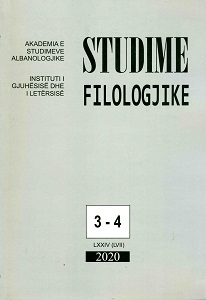Diateza si mekanizëm gjuhësor kompleks për të formuar konstrukte alternuese në gjuhën shqipe
Diathesis as complex linguistic mechanism of creating alternating constructions in Albanian
Author(s): Anila KananajSubject(s): Language studies, Syntax, Philology
Published by: Qendra e Studimeve Albanologjike
Keywords: Albanian language; Diathesis; syntax; linguistics;
Summary/Abstract: Diathesis constitutes one of the most difficult and nonetheless very much talked about in linguistics. There is not a unified, satisfactory definition and explanation that is accepted by all linguists for it. In the tradition of grammatical studies, the treatment of diathesis mainly as a morphological category, and to some extent semantic, has failed to reflect the features it realizes in the interfaces of several linguistic disciplines. New contemporary theories as well as expanded quantitative and qualitative studies which focus on the verb have brought significant contributions in the science of linguistics in general and in the study of specific languages, especially in the Germanic languages, in Latin, in Slavic languages, etc. I consider it an immediate need for Albanological studies to provide contemporary results regarding diathesis. For this purpose, in this paper a new approach is proposed and pursued, aiming to provide solutions to some issues that have not yet received satisfactory answers in relation to this issue in Albanian. To achieve this objective, I firstly offer an analytical review of current domestic studies (Sheperi 1927; Myderrizi 1944; Cipo 1949; Demiraj 1969; Lika 1970; Thomai 1984; Teichmann 2010; Deda 2017; Karapinjalli 2017 etc.) and foreign studies (Pollard and Sag 1987; Fillmore 1965, 1988; Goldberg 1995, 1996, 2002, 2006; Jackendoff 1997, 2015; Levin 1993; Booij 2005; Cappelle 2006; Bresnan et al. 2007; Croft 2012; Perek 2012; Van de Velde 2014, Haspelmath 2021 etc.), in order to clearly understand the achievements, shortcomings, limitations and the real need for a new theoretical approach, as well as for a new conception of diathesis in the Albanian linguistics. By firstly differentiating between the morphological category of voice (in Albanian: “formë’, “zgjedhim”) and diathesis, I see the latter in close interaction of several linguistic planes, specifically in the interface of semantics, morphology, syntax and pragmatics, as a result of the unification of their features. Diathesis then results in a complex linguistic operation which acts on the structure of the sentence and forms idiosyncratic constructs that change the vaience of their central verb. The constructs formed by means of diathesis operations contribute to specific semantic and syntactic alternations in the Albanian language. Lastly, an important number of twenty alternations constructs in Albanian are described and analyzed. I classified diathetic alternations in Albanian into two main types: I. Symmetric alternation constructs, and II. Asymmetric alternation constructs. The first type includes verbs that realize the formal opposition active form - inactive form of the verb. The second type includes verbs that do not express this opposition. The first type was further divided into two subgroups: a) complete symmetric alternations, and b) partial symmetric alternations. The first group includes verb-based constructions that preserve the sentence proposition, they preserve the semantic roles and the number of valences, but the grammatical type of valences changes. The second group includes constructs that express a new or a different proposition in the active - inactive opposition of their verbs. This approach is new in Albanian studies.
Journal: Studime Filologjike
- Issue Year: 2020
- Issue No: 03-04
- Page Range: 109-152
- Page Count: 44
- Language: Albanian

